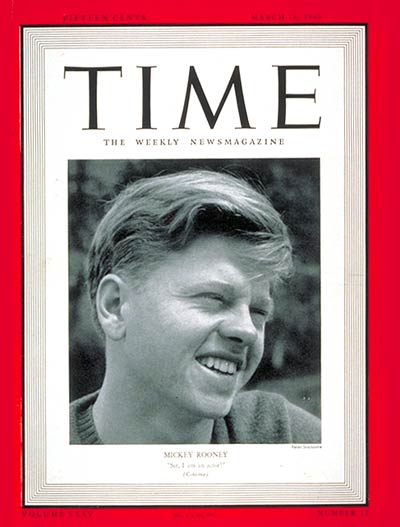THE FILMS OF RADIO CITY MUSIC HALL
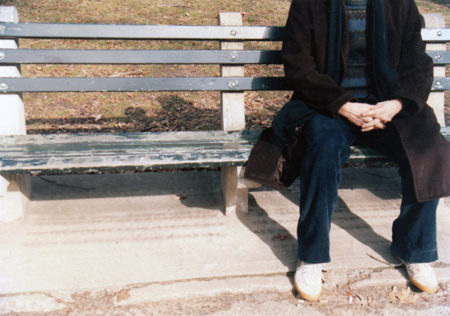

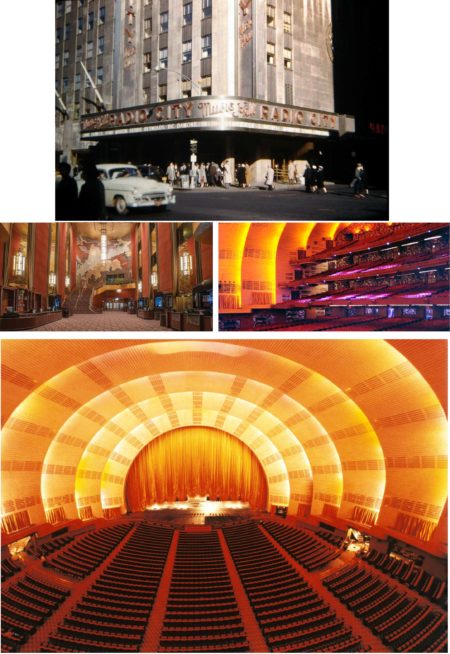
THE FILMS OF RADIO CITY MUSIC HALL
Another book proposal that I wrote which didn’t go anywhere was THE FILMS OF RADIO CITY MUSIC HALL. Because Radio City Music Hall could rack up massive grosses it was the theatrical outlet preferred by the studios and for good reason. If a film played at the Music Hall a studio would advertise those grosses in the trades and this would mean additional bookings. And, this was the reason why the Music Hall played some of the very best films made during the 1930s, 40s, 50s and the 1960s. The list of great films that played there is staggering, and it was because of these I great films that I believedThe Films OF Radio City might make a wonderful book.
It was designed to be a large coffee table book and—filled with illustrations and short descriptions of the films—would echo DAVID SELZNICK’S HOLLYWOOD; in my opinion, the greatest film book ever published. Packed with illustrative material from my own collections, the actual proposal was very impressive; so impressive that, after it made the rounds, my agent refused to give it back to me as he wanted to keep it for himself. If only publishers could like your work as much as your agent, publishing would be a very different world.
Before embarking on this project, I didn’t know that a book of this sort book needed to be done in conjunction with an institution–in this case Radio City Music Hall. The reason for this is purely financial. In order to make a publication of this kind economically feasible, the music Hall would need to guarantee to purchase of a large order books that they would sell themselves. This order would insure that the book would at least break even and would be a hedge for the publisher. Unfortunately, the Music Hall wasn’t interested and their lack of interest translated into a lack of interest on the part of publishers and that, as they say, was that.
So publishers might have an idea of what the book’s text would be like I wrote four sample entries. The titles were selected so they would be representative of the films that played the Music Hall.
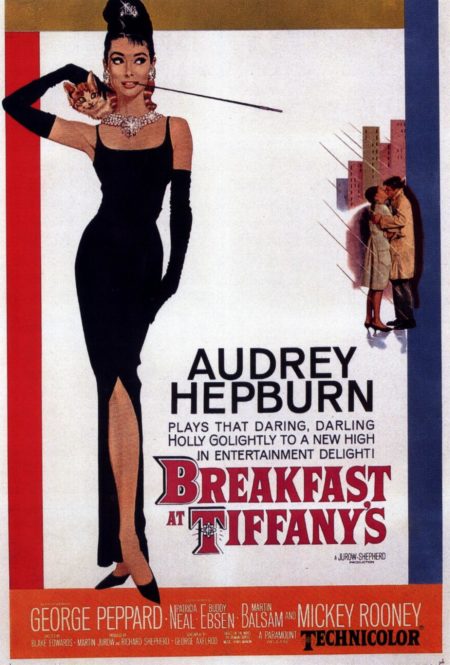
BREAKFAST AT TIFFINY’S
“I think Blake Edwards made the most influential movie in the area of breaking down old taboos and letting the age of permissiveness come in,” was pornographer Radley Metzger’s assessment of BREAKFAST AT TIFFANY’S. “I don’t think anybody realized what a giant step that picture represented and the acceptance of it by the public.”
Difficult to grasp today, but in 1961 BREAKFAST AT TIFFANY’S was a daring film. Audrey Hepburn, after playing two princess, one nun and an assortment of virgins, had taken on in the role of Holly GoLightly who was essentially, a stylish call girl. In addition, her love interest, played by George Peppard, was a kept man being supported by an older woman (Patricia Neal) in exchange for sex. The film may have been wrapped in a comedy and packaged as ultra-sophisticated but, in essence, BREAKFAST AT TIFFANY’S is a love story between two whores.
Truman Capote’s original novella, written in 1958, was an amoral presentation of, what was popularly called in the 1950s, ‘a kook.’ The story’s narrator was a non-character who related his experiences with neighbor Holly GoLightly, a character loosely based on Capote’s good friend Carol Matthau. Without any visible means of support GoLightly wined and dined with New York’s jet set and managed to pay her bills by going out two or three times a week with men who dutifully gave her $50.00 for “the Powder room”. Almost everything about Holly was daring, original, and out-of-the-ordinary.
When it came time for George Axelrod to adapt the story for the movies he did it with a skillful knowledge of what American audiences would find acceptable. Holly remained a kook and was still a tramp but some twists were added to the story. The non-character narrator became an uptight “writer” who, played by George Peppard, developed into the story’s love interest. His being kept was an Axelrod fabrication and a shrewd way of making Holly’s $50 powder room “tips” seem alright in what was presented as hip 1960’s New York. In Axelrod’s translation both characters eventually realized what they were doing was wrong and by film’s end had fallen in love. After various pitfalls and crisis, all for the most part lifted from the book and changed around to suit Axelrod’s adaptation, each character redeemed the other and were off to a moral married life. It was the old boy meets girl, loses girl, gets girl story but with some very new twists.
Capote hated the movie and was fond of telling people that “they made a big boring mawkish Audrey Hepburn valentine out of it.” He had a right not to like it. It wasn’t his Holly. His Holly was a hopelessly superficial, amoral woman who persevered through setbacks and difficulties without once questioning or wanting to change her way of her life or developing a single regard for another
Director Blake Edwards, who admired Capote’s story, but understood what had to be done to it, also knew what he could slip by audiences in 1961. Fifteen years later when asked what he would change if making the film then, Edwards was blunt. “I would insist on it being more faithful to the Holly Golightly that Capote really wrote about but I don’t know if Audrey would have wanted to play that Holly.” Hepburn had fought to make the character more sympathetic.
In any case what Edwards did make was a wonderfully funny, comically inventive commercial film in which Audrey Hepburn sparkled. She had never looked more beautiful or wore clothes more chicly. Her Givenchy clothes set fashion all over the world.
The Film was a success financially ($4,200,00 in domestic rentals) and a personal success not only for Hepburn, who was Oscar nominated, and Director Edwards who was about to become a one of America’s most prominent filmmakers but also for Mickey Rooney.
Rooney, who by 1961 had embarked on a second career as a character actor, provided brilliant support for Hepburn in the role of her complaining Japanese Neighbor Mr. Yunioshi. With protruding teeth, slanted eyes, dressed in Japanese robes, pounding his bare feet as he walked, Rooney’s performance was so remarkable that many viewers didn’t even know it was Mickey Rooney but thought he was a real Japanese actor. Rooney managed to turn a small part into one of the most memorable roles in the film. It might not be politically incorrect today but in 1961 Rooney’s portrayal was a comedic joy.
********
BREAKFAST AT TIFFANY’S opened at Radio City on October 5, 1961 and closed on November 8. At a general admission top price of $1.50, the 114 minute film grossed $761,000 during its five week run.
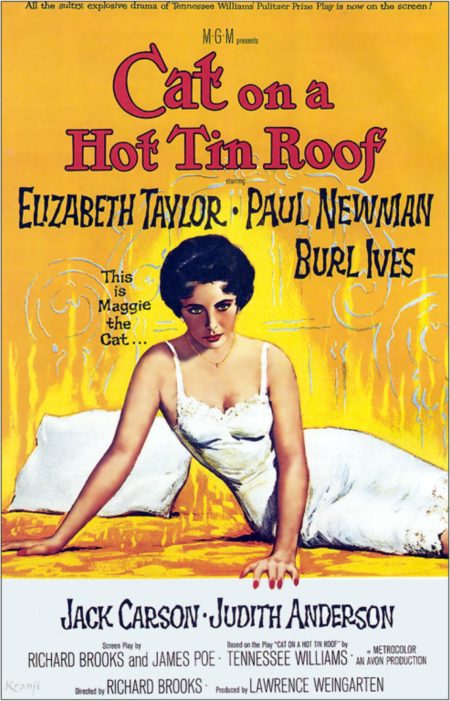
CAT ON A HOT TIN ROOF
On March 22, 1958, two weeks into the production of CAT ON A HOT TIN ROOF, Elizabeth Taylor’s husband, Broadway and film producer, Mike Todd was killed in an airplane crash. The news left Taylor devastated and so hysterical that doctors had to keep her heavily sedated for the next week. In addition to husband and lover, Todd had also become a father figure for Taylor having taken over the management of her business affairs. Now, without him Taylor felt completely adrift—shock soon being replaced by deep and overwhelming depression. Nevertheless she pulled herself together and on April 14 rejoined the cast of CAT.
What cast and crew saw on that sound stage over the next several weeks was startling. Taylor, still in the midst of profound grief, was bringing her character, Maggie The Cat, to life with an energy and a force that Taylor had never displayed before as an actress. During a period when another performer might fallen apart emotionally, Taylor was digging down into the well of her inner resources and pulling out a great performances.
To interviewers she would say, “I was so lucky that I had someone else to become at a moment when I had gone slightly around the bend with grief. When I was Maggie it was the only time I could function. The rest of the time I was a zombie.” During rehearsals Taylor would be listless and distant; unable to connect with other performers. But as soon as the camera was turned on she would come alive with electricity.
Never a polished actress. Taylor was an enormously talented but intuitive performer who had the discipline and courage to try anything. With Maggie The Cat she extended her reach beyond anyone’s expectation. She filled out Maggie’s high strung and sexually frustrated dimensions with an explosive honesty that out-matched anyone else in the film. All one has to do is watch Taylor in her scenes with Paul Newman. She gives the scenes between Maggie and her sexually impotent husband a tension which wouldn’t be there if it wasn’t for Taylor.
When CAT ON A HOT TIN ROOF opened at Radio City in the fall of 1958 most reviewers commented on Taylor’s performance and praised the excellence of the overall film. But in general they were disappointed with writer-director Richard Brooks having, because of the censors, weakened the play’s homosexual subtext. In the film the Newman character avoids sleeping with Maggie not, as in the play, because of his suppressed homosexuality but because of his reluctance to assume the responsibilities of an adult.
These reviewers didn’t know that Williams’s had reluctantly tampered with and weakened his own play even before it opened on Broadway. Its director, Elia Kazan, had successfully pressured Williams into softening the play’s ending and making Maggie a more admirable character. Williams, who considered CAT his best play, never wavered from his opinion—even when the play went on to became his greatest success and earned him a Pulitzer Prize— that these changes had damaged the play. It wasn’t until the mid-seventies when ABC Television broadcast the play was CAT finally presented as Williams had originally written it.
But in 1958, after receiving a $450,000 check for CAT’s screen rights, Williams kept his mouth shut about the film’s changes and even allowed MGM publicists to send out reports that these changes had been made with his consent. Grossing close to $9,000,000 in domestic rentals CAT eventually became the third highest grossing film (behind SOUTH PACIFIC and AUNTIE MAME) of
Financially Elizabeth Taylor and Paul Newman didn’t do nearly as well as Williams. CAT ON A HOT TIN ROOF was Elizabeth Taylor’s last MGM film under her old salary contract. The 4,850 a week she was paid earned her just under 30,000 for the six weeks that she worked on the picture. Newman, on loan from 20th Century Fox, received a flat 25,000. Nevertheless the film’s enormous success and the success of the stars’ subsequent movies would change things dramatically. Within three years Taylor would be receiving a million dollars a picture and Newman a few hundred thousand less as they became the two most important and sought after stars of the 1960s.
*********
CAT ON A HOT TIN ROOF opened at Radio City on September 18, 1958 and closed on November 5th. At a general admission top price of $1.50, the 108 minute film grossed 966,500 dollars during a seven week run.
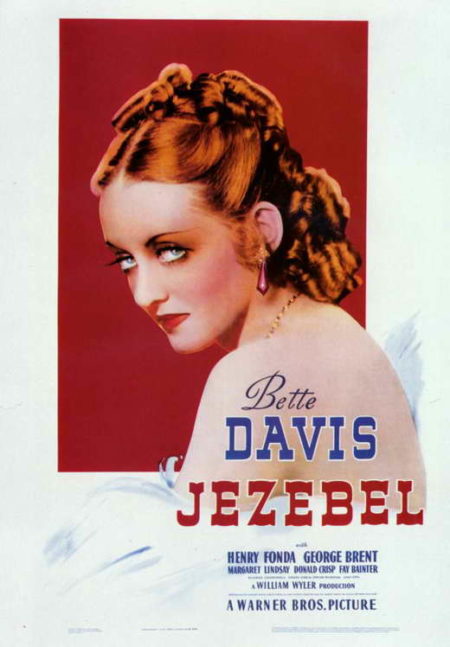
JEZEBEL
When production began on JEZEBEL in October 1937 Bette Davis found herself in the midst of the most creative professional collaboration of her career. William Wyler, her brilliant and demanding director, was pushing, prodding and cajoling out of Davis the most important performance of her career. Publicly Davis would say, “It was Wyler who helped me realize my full potential as an actress.” Privately it was another matter. She would scream at anyone who would listen that it was her own pigheadedness that had lost her Wyler, the most passionate affair of her life.
JEZEBEL was a peace offering. Three years earlier, feeling that her 1935 Best Actress Oscar had earned her the right to better roles, Davis bristled at the second rate program films Warner Brothers was still offering her. She was under an iron clad contract to the company that left her with no say in the selection of her roles. It was when Warners sent her the script for something called
Warner Brothers sued and when a London Judge ruled against her, Davis was forced to return to Hollywood. The studio may have beaten her in court but gave into her on the lot. She now had her pick of the studio’s best properties. MARKED WOMAN, KID GALAHAD, THAT CERTAIN WOMAN and the Jewel in that crown, JEZEBEL, were all offered to her.
JEZEBEL began its history on Broadway. Staring Miriam Hopkins the play was set in antebellum Louisiana, its heroine a tempestuous Southern belle. With David Selznick’s publicity department fueling his GONE WITH THE WIND Scarlett O’Hara search—and that southern story— still a year away from filming, Warners thought the time was right and so put JEZEBEL into production.
It was allocated, for penny pinching Warner Brothers, the huge budget of $783,000. William Wyler was borrowed from Goldwyn to direct, Henry Fonda signed to co-star and John Huston hired to write. Bette Davis had finally gotten the “high budget film with all the trimmings” she had “fought for and a talented director that” she “had been begging for.”
The first thing Wyler did was ignore the budget. The second thing he did was to ignore the considerable pressure Warner executives were applying to get him to quicken his pace. With nerves of steel, as he escalated the final budget to over a million dollars, Wyler took his time. Shooting take after take he began to fill the film with the nuance and detail for which he was noted. At a studio where five or six takes was considered high, Wyler was sometimes shooting 30 and 40.
Davis marveled at her director’s single minded dedication. She would later write, “I had known all the horrors of no direction and bad direction. I now knew what a great director was and what he could mean to an actress.” Before making JEZEBEL Davis had always locked into a performance, never varying it from the first to the 10th take. Wyler taught her to see takes as rehearsals and try new and different things each time the camera was turned on. He screened JEZEBEL footage for the actress and showed her how a great performance could be pieced together from the spontaneous and intuitive responses actors give when they felt free to experiment in front of the camera. So, instead of bristling at having to do things over and over, Davis begin to work with Wyler. She and her director were soon finding the gestures and reactions which eventually helped Davis create her first fully realized film performance and win a much deserved second Oscar.
The actress-director rapport was so great that it wasn’t long before the two no longer needed to speak to each other to get what they wanted. A look was usually sufficient. It was inevitable that this rapport would transfer, as it often did with Davis, to the bedroom. As in their creative collaboration their personal relationship was based on the union of two brilliant strong willed individualists. When in harmony their passions knew no bounds. In disharmony their fights and arguments would leave them shaking. When Wyler brought up the subject of marriage Davis sidestepped it. She had always married weak men whom she could control but she couldn’t control Wyler and that aspect of their relationship frightened her away from any sort of permanent commitment to the director.
The affair went on for months. When they were speaking it was wonderful. When they argued they wouldn’t see each other for weeks. Finally during one of the separations Wyler sent Davis a letter. Feeling touchy and wanting to “show him” she refused to open it.
A few days passed and she finally tore the letter open. He wanted her to call him. But, the letter went on to say, if she chose not to respond he would realize that it was finally over between them and marry someone else. She was still trying to reach him when she heard over the radio that Wyler had married a young starlet. This was October 23, 1938, a year and two days after JEZEBEL began shooting.
Forty Years later Davis was emotional when she spoke to an interviewer about this. “Oh why didn’t I marry Willie? It might have worked out. I was just too scared Silly. Now after four husbands I realize he was the love of my life.”
*********
JEZEBEL opened At Radio City Music Hall on March 10, 1938 and closed on March 23. At a general admission top of 99 cents, the 104 minute film grossed 144,300 dollars during a two week run.

YOUNG TOM EDISON
A film biography of Thomas Alva Edison was a decade long dream project for producer John Considine Jr. At MGM since the early 30s mostly producing program features, Considine finally hit it big with BOY’s TOWN in 1938. The Father Flanagan biography was a huge success, garnered its star, Spencer Tracy, a second Oscar and earned Considine the clout that enabled him to proceed with his Edison biography.
In 1939 the accepted procedure in filming biographical films was to devote a small portion of the films early section to the hero’s boyhood, then flash forward to him as an adult. Considine and MGM decided to try something different. They cast Spencer Tracy in EDISON THE MAN, the biography of the adult Edison and cast Mickey Rooney as YOUNG TOM EDISON in an account of Edison’s exploits as a boy. The films would be made back to back with YOUNG TOM EDISON released first and EDISON THE MAN released a few months later.
Hollywood had never attempted a two part biography and for MGM, the most conservative of the major film studios, it was a surprising move. The key ingredient to the project’s success was Mickey Rooney. In 1939, 1940 and 1941, due in the main to his Andy Hardy movies, Rooney was the top box office attraction in the United States. The talent and range this 18 year had displayed since starting in movies at the age six was an industry phenomenon. Rooney could do comedy. He could do drama. He could sing. He could dance. He could even play musical instruments with the skill of a seasoned professional. One MGM star put it succinctly. “Mickey Rooney was the most talented person” she had ever met.
Not wanting to pigeonhole an actor with this enormous versatility in just Andy Hardy features by 1939, when YOUNG TOM EDISON went into production, MGM had already started broadening the appeal of Rooney’s starring roles. A Year before, with BABES IN ARMS, they not only launched him in musical comedy but helped Rooney earn a best actor Oscar nomination.
When YOUNG TOM EDISON offered Rooney another opportunity to break out of the Andy Hardy mold, the young actor jumped at the chance to play the 16 year old genius. His main concern taking on the role, as Rooney would later write in his autobiography, was to present audiences with Tom Edison and not just another variation of Andy Hardy. He immersed himself in the part and during long periods of the production became Tom Edison on and off the set. He would often say that it wasn’t him doing all those things, it was Edison. Even though the film’s account of Edison’s early years was somewhat fictionalized, Rooney felt it gave the essence of the man and to this day he considers it among his best film work.
The film turned out to be everything its star and producer had hoped for. After a February 1940 world premiere in Edison’s boyhood home, Port Huron Michigan, the film played a successful Easter engagement at Radio City. The reviews were laudatory and over the next year it did well in general release throughout the United States as did EDISON THE MAN which premiered at the New York’s Capital Theater three months later.
When both films reached the small towns some enterprising exhibitors took it upon themselves to remove the closing credits of YOUNG TOM EDISON and spliced the film into the beginning of EDISON THE MAN thereby showing the two films as a single 189 minute biography of Thomas Edison. For producer John Considine it was a dream come true.
********
YOUNG TOM EDISON opened at Radio City Music Hall on March 14, 1940 and closed on March 27th. At a general admission top price of 99 cents, the 82 minute film grossed $179,500 during its two week run.
